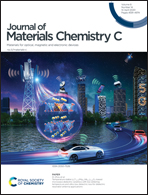A controlled growth of triangular AuCu alloy nanostars and high photocatalytic activities of AuCu@CdS heterostars†
Abstract
Metallic nanostars have tunable plasmon resonances and high photocatalytic activities; however, controlling the number and length uniformity of branches for the colloidal nanostars is still a challenge. Herein, we report a successful growth of triangular nanostars of an AuCu alloy by tuning the atomic ratio of Cu (γCu = 0.36). The growth kinetics is dominated by the γCu, and the evolution from triangular to pentacle nanostars is observed. The triangle AuCu nanostars have a uniform branch length and therefore exhibit strong strength of surface plasmon resonance in the near-infrared region. Furthermore, we demonstrate plasmon-enhanced photocatalytic performance by overgrowing CdS nanocrystals onto the triangle AuCu nanostars. The hydrogen production rate of the AuCu@CdS heterostars reaches 607 μmol g−1 h−1 under light irradiation (λ > 420 nm), which is 2.94 times the sum of that of the pure CdS nanoparticles and the triangular AuCu nanostars. These observations provide an approach to control the morphology of plasmonic nanoantennas and may find the applications ranging from bio-sensor to photocatalysis.



 Please wait while we load your content...
Please wait while we load your content...